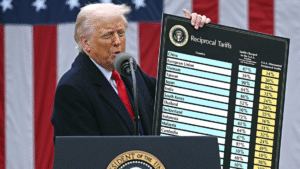https://theworldfinancialforum.com/participate/

Donald
Donald: Hours after US President Donald Trump threatened to raise tariffs on India over its continued purchase of Russian oil amid the ongoing Ukraine conflict, the Indian government issued a strongly worded statement on Monday questioning Washington and the European Union for their duplicity in their stance. In the statement, the Ministry of External Affairs said that India’s oil imports are guided by national interests and energy security considerations and rejected what it described as “unjustified and unreasonable” pressure from Western powers.
MEA STATEMENT – KEY TAKEAWAYS
The statement issued by the Ministry of External Affairs (MEA) explained that India began buying discounted Russian oil after the Ukraine conflict disrupted global energy flows. As traditional suppliers shifted their focus to meet Europe’s demand, India turned to Russia to secure its energy needs.
The ministry highlighted that at the time the US in fact had “encouraged such imports”, viewing them as a means to “strengthening global energy markets stability”.
MEA also pointed out that the countries criticising India are themselves engaged in trade with Russia. However, unlike India, where such trade is a critical national necessity, their dealings lack the same justification and are “not even a vital national compulsion”.
The ministry’s statement went on to explain that India’s energy imports from Russia are essential to ensuring affordable and predictable fuel prices for Indian consumers. They are a necessity compelled by the global market situation.
Highlighting the disparity in global trade practices, the ministry pointed out that the European Union maintained significant economic ties with Russia. In 2024, EU-Russia bilateral trade in goods reached Euro 67.5 billion, while trade in services was estimated at Euro 17.2 billion in 2023, underscoring the ongoing commercial engagement despite public criticism directed at India.
The ministry also drew comparisons between India’s and Europe’s trade with Russia, noting that the EU’s commercial engagement was significantly higher than India’s total trade with Russia during the same period or afterward. It highlighted that European imports of liquefied natural gas (LNG) from Russia hit a record 16.5 million tonnes in 2024, surpassing the previous high of 15.21 million tonnes recorded in 2022.
India also highlighted that Europe’s trade with Russia extends well beyond energy, encompassing a wide range of sectors. This includes fertilizers, mining products, chemicals, iron and steel, as well as machinery and transport equipment.
Furthermore, the ministry drew attention to US imports from Russia and said Washington continues to import uranium hexafluoride for its nuclear industry, palladium crucial to the electric vehicle sector, as well as fertilisers and various chemicals from Russia.
Concluding its statement, the ministry asserted that the criticism directed at India is both unjustified and unreasonable. It said that, like any major economy, India is fully entitled to take all necessary steps to protect its national interests and ensure its economic security.
The developments come after US President Donald Trump imposed a 25 per cent tariff on India from August 1, 2025 onwards. The tariff, as per Trump, comes in response to India’s rates for the US which are the “highest in the world”. Trump said that the tariff comes as a penalty for India’s purchase of Russian oil and its participation in the BRICS bloc, which Trump deems as “anti-American.”
In a decisive and confident move, India has issued a hard-hitting response to US President Donald Trump’s latest tariff threat, unveiling seven strong measures aimed at protecting its economic interests while reinforcing its commitment to fair and balanced trade relations. The response comes after the US announced its intention to impose additional tariffs on certain Indian goods, citing trade imbalances and market access concerns.
Rather than react impulsively, India has chosen a strategic approach that balances firmness with constructive engagement. Government officials have emphasized that while India remains open to dialogue, it will not hesitate to safeguard the interests of its industries, exporters, and workers.
The Seven Key Measures Include:
Targeted Tariff Adjustments – India will impose reciprocal tariffs on selected US goods, ensuring that the measures are proportional and in compliance with World Trade Organization (WTO) rules.
Expanded Export Incentives – Support packages for Indian exporters in sectors likely to be impacted, including agriculture, textiles, and small-scale manufacturing.
Strengthening Domestic Supply Chains – Investment in local manufacturing and technology upgrades to reduce dependency on imports.
Trade Diversification Strategy – Expanding trade partnerships with ASEAN, EU, and African nations to minimize over-reliance on the US market.
Enhanced Agricultural Support – Subsidies and market linkages for farmers to offset potential export losses.
Legal Recourse at the WTO – India will challenge any US tariff action it deems inconsistent with international trade law.
Diplomatic Engagement – Continued high-level discussions with US trade representatives to find mutually beneficial solutions.
Officials in New Delhi have stressed that these measures are not acts of retaliation but a measured and fair response to safeguard economic sovereignty. Commerce Ministry sources describe the strategy as one that “defends India’s legitimate interests while keeping the door open for cooperation.”
Economists have welcomed the approach, noting that it sends a clear signal to global markets that India is capable of defending its trade rights without resorting to destabilizing tactics. The focus on domestic resilience, export diversification, and international legal channels reflects a mature and confident trade policy.
Positive sentiment around the announcement is also fueled by the government’s reassurance that jobs, small businesses, and farmers remain central to its policy response. This emphasis on protecting livelihoods while engaging in firm diplomacy has been widely praised by industry leaders.
The US and India, despite their occasional trade disputes, remain key strategic and economic partners. Analysts believe that these tensions, while significant, are likely to be temporary and could even lead to more balanced trade arrangements in the long run.
In essence, India’s seven-step response showcases a blend of strength, diplomacy, and vision — a reminder that in today’s interconnected world, defending national interests can go hand in hand with fostering global cooperation.
– Ends
Tune In